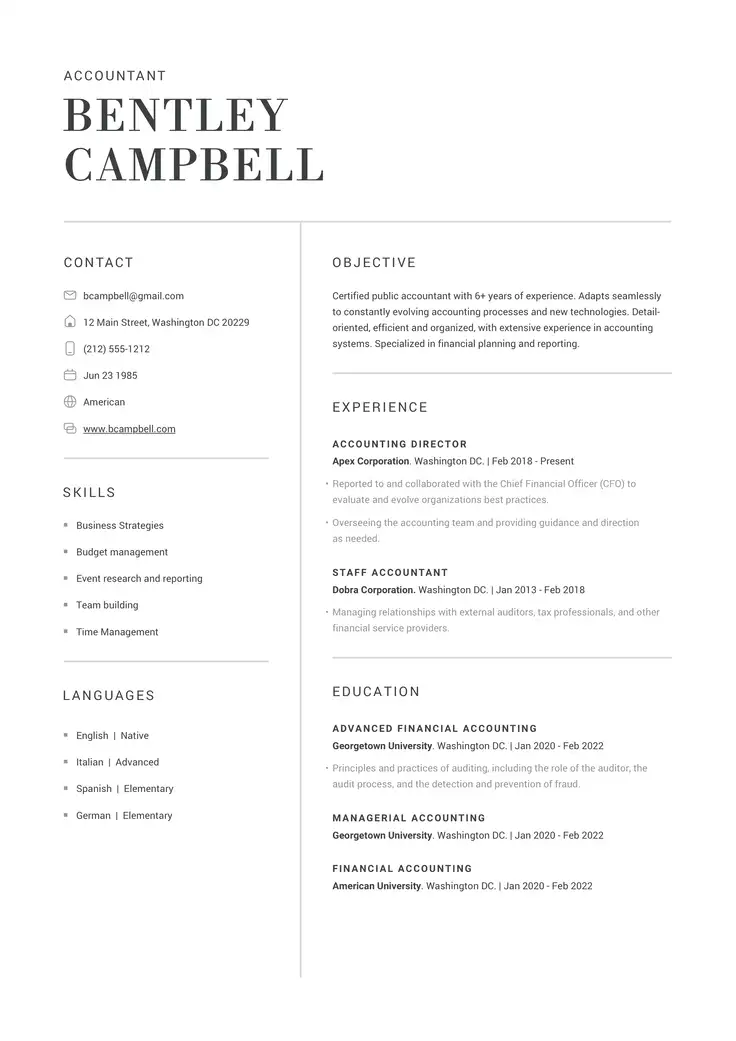Sometimes, having the right education and experience is not quite enough to land the job you want. You may need to obtain additional certifications and include them on your resume.
What are certifications? How should you list certifications on your resume to make sure they are seen and make the right impression?
What is a Resume Certification Section?
If you’ve been working on your resume, you might have noticed an optional section called “Licenses and Certifications.” This section is not required like the Skills, Work Experience, and Education sections are.
What does the Certifications resume section contain? A certification is defined as “an official document attesting to a status or level of achievement.” Therefore, if you want to list something as a certification on your resume, you should have a document (physical or digital) to back it up.
Licenses are commonly included as well. For example, you might need to list a nursing license or a specialized driver’s license. Always include the license number.
What are the best certifications to put on your resume? Determining which certifications look good on a resume largely depends on your career goals. Choose certifications that are relevant to your career path – those that are well-recognized and demonstrate skills you use in your job every day.
In some cases, obtaining highly sought-after certifications can result in a promotion at your current job. Ask about company programs promoting certification. Some employers will even reimburse you for the cost of certification.
There are also a number of certifications that highlight transferable skills valuable to many occupations. These include:
- CRP Certification – valuable for any public-facing job, especially those serving children.
- Certified Public Accountant (CPA) – every company requires an accountant or bookkeeper, either outsourced or in-house.
- Microsoft Technology Associate (MTA) – a powerful entry-level IT certification.
- Microsoft Certified Professional (MCP) – a more advanced IT certification. More than half of businesses rely on Microsoft products.
- Project Management Certification – beneficial in most management positions.
- Process Management Certification – beneficial in careers requiring oversight of logistics or product manufacture.
- Certified Medical Coder – useful in all medical offices.
- Actuary Certification – an advanced certification for those with degrees in mathematics, finance, or statistics.
- Salesforce Development Lifecycle and Deployment Architect Certification – a wide range of businesses rely on Salesforce technologies.
- OSHA Workplace Hygiene and Illness Prevention Certification – a certification in high demand following the COVID-19 pandemic.
- Fire Safety Certification – beneficial in any business operating in a designated location. Many such businesses are required to establish fire escape or containment plans.
- Purdue University Diversity and Inclusion Certification – increasingly beneficial in a globalized economy, this certification offers a greater understanding of the attitudes and skills needed to work effectively with different people.
- Oxford Home Study’s Office Administration Certification – valuable in almost any industry, as it hones business administration expertise.
- Microsoft Office Specialist: Excel Associate Certification – valuable to any business that utilizes Microsoft Excel software in its recordkeeping.
- Google Ads Certification – many companies utilize this advertising resource in their marketing campaigns.
- WordPress Certification – Many companies use WordPress as the basis for their websites.
You can find many other online courses for which you will receive a certification of completion on resources such as Universal Class. If you need continuing education credits to renew a certification, you may be able to utilize these classes.
Remember, it is never too late to begin collecting relevant certifications. Many can be completed online. Some are even free of cost. You never know when your certifications could help you on your next job search.
When to Include Licenses and Certifications on Resume
While the listing Certifications on your resume are not always required, they can be expected when applying to certain career types. At other times, the Certifications section can strengthen your resume and increase your chances of getting the job.
There are three categories of circumstances when you should always give attention to adding certifications to your resume.
When Specific Certifications Are Required
When a company specifies that applicants must have a certain certification or a range of certifications, the Certification section becomes the most vital. If the job advertisement lists a certification as a requirement, you are not likely to get the job without it.
What if you don’t have the certification listed? One option is to obtain it. If you are already a part of the industry and have the needed knowledge and experience, you may be able to get certified quickly and easily.
Even if you are new to the industry, you may desire to pursue the certification – even if this job may be filled by the time your certification is complete. After all, if you are striving for a career change, you will most likely need the certification when applying for similar jobs.
If you have other relevant certifications or licenses in the field, you may decide to list these in hopes that they will “cover” the necessary certifications requirement.
Finally, if you are in the process of obtaining the needed certification, you may say so in your cover letter, along with your expected date of certification. We’ll talk more about how to record in-progress certifications in the “How to” section below.
When They Are Relevant to the Job
Sometimes, certifications are not required, but they still represent skills that would be helpful for the job you seek. For example, if you are applying for a job as an elementary school teacher’s aid and you are CPR certified, that could be a useful skill. Or, if you are certified in various computer languages, this would be useful in any job that involves frequent use of computer technology.
When They Make Up for a Lack of Experience
When you are trying to break into an industry, you may have little or no relevant experience to report. If you have the right certifications, however, an employer might overlook your lack of experience, confident that you have the skills needed to do the job.
How to List Certifications on Your Resume
The Certifications section follows a similar format to other resume sections. After the heading, each certification listed should include the following information:
- Certification name
- Certifying organization name
- Date earned
- The location where the certification was completed (city, state, or “Online Course”)
If you are currently in the process of obtaining a certification, you can still list it on your resume. Simply add the words “In Progress” following the certification name.
Where on your resume should the certifications section reside? There are two places that employers may expect to find it. If your licenses or certifications are extremely important to get the job (i.e., they are required), you should put them near the top of the resume. In fact, they can come immediately after your contact information.
If your skills are less relevant or you are simply using them to flesh out your resume, you can place the Certifications section in a sidebar or at the bottom of the resume.
Another option is including Certifications in your Skills Section. This may be helpful if you have only one or two certifications, and if your certifications are directly related to your skills – for example, if your key skills and certifications all deal with computer sciences. In this case, you can rename the skills section “Skills and Certifications.”
Now, let’s take a look at a real-world example of a resume with certifications.
Sample Resume With Certifications
Check out this certifications on a resume example. Jane is applying for a nursing role at a local hospital. Her resume might begin in this way:
Jane Doe
555.555.5555
janedoe@gmail.com
123 Front Street, Anywhere, NY, USA
Licenses and Certifications
Registered Nurse
New York State Board of Nursing
2019
New York, NY
License #123456789
Basic Life Support (BLS) Certified
American Heart Association
2020
New York, NY
Did you notice that Jane listed her licenses and certifications at the beginning of her resume, right after her contact information? Since licensure is required in her profession, she wanted to draw attention to it immediately.
Let’s look at another example. This time, Kyle is a recent graduate. He’s trying to break into the IT industry but he has no previous work experience.
Kyle Jones
555.555.5555
kylejones@gmail.com
123 Home Street, Anywhere, CA
Certifications
Microsoft Technology Associate (MTA)
Microsoft Corporation
2021
Online Course
CompTIA Cloud+
CompTIA
2022
Online Course
Certified Ethical Hacker (CEH)
EC-Council
2022
Online Course
Education
Associate of Science in Information Technology
Anywhere Community College
Anywhere, CA
2021
Even though Kyle does not have previous work experience, he does have an impressive retinue of IT-related certifications. It should be clear to his hiring manager that he has the skills needed to perform IT duties.
Key Takeaways
- Licenses and Certifications is an optional resume section that contains training for which you have received official documentation upon completion.
- Employers may require specific certifications. Or, they may demonstrate relevant job skills, helping you make up for other experiences.
- It is never too late to pursue certifications relevant to your career field or transferable across industries.
- Include the certification name, awarding organization, location, and year obtained in each certification listing.
Related Posts




